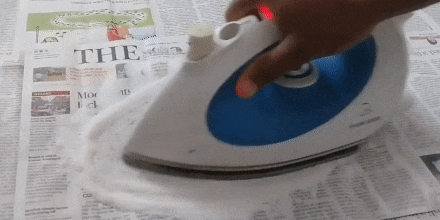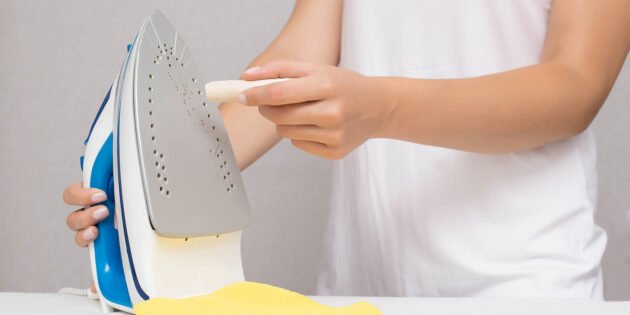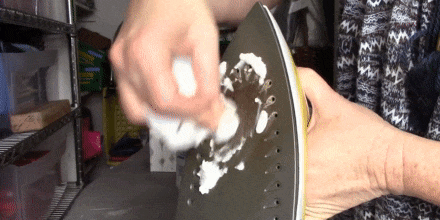Sandpaper, a knife or other sharp objects will definitely not work for cleaning the iron. This scratches the sole and can lead to incorrect operation of the device.
Before you start cleaning, determine which method is suitable for your equipment. Ceramic or Teflon soles, for example, cannot be rubbed with abrasives, so you should choose more gentle methods from those listed below.

This method will cope with small and fresh spots of carbon. Pour salt on a sheet of paper in an even layer and run a hot iron over it until the blackness comes off.

Wrap the candle in a cotton cloth and rub the hot sole of the iron with circular movements. Hold the device over a pallet or a layer of newspapers: in the process, the candle will melt, and the paraffin will flow down.
Be careful if the working surface of your iron is embossed or has holes for steam. Paraffin can get into the recesses and stain things during subsequent ironing.
When the soot comes off, carefully remove the remnants of dirt and molten candles .
Apply a small amount of paste to a warm iron. Rub well with a soft cloth or sponge, leave for 15-20 minutes. Wipe off the remaining paste with a damp cloth.
This tool will help to remove only weak impurities. Moisten a cotton swab or a piece of cloth in 3% hydrogen peroxide. Carefully and with effort wipe off dark spots from the surface of a cold iron.
Moisten a cotton swab in the solution and wipe the sole of a cold iron . If the carbon is strong, add ammonia to the vinegar in a ratio of 1: 1.
If this does not help, soak a cloth with vinegar and cover the working surface of the device with it for several hours. During this time, the raid will soften. Remove it with a sponge or a soft brush.

Dissolve a few tablespoons of soda in a glass of water, moisten a piece of cloth in this solution and wipe the cold surface of the iron. After cleaning the iron from stains with a damp sponge.
If a piece of polyethylene is stuck to the sole of the iron, it can be removed with a nail polish remover. When cleaning, try not to touch the plastic parts of the iron: substances in the liquid can damage them.
In stores you can find a special tool for cleaning irons. It looks like a candle and contains acids in the composition, which cope well with rust and carbon deposits, but do not damage the coating of the sole.
Preheat the iron and place it vertically, draw a pencil along the sole. Make sure that the product does not leak into the steam outlet holes. Turn off the appliance and quickly wipe the surface with a damp cloth. If the carbon does not come off immediately, repeat the procedure again.
Choose a pencil
To prevent carbon deposits from appearing again, follow these tips:
If the steam supply function has started to work poorly, and the iron leaves red spots on clothes, most likely, scale has formed in it. Two methods will help to remove it completely.
In many modern models, the manufacturer took care of the scale problem. Check the instructions: maybe you just have an iron with a self-cleaning function. To carry it out, follow the manufacturer's advice. Usually the algorithm is like this:
After the procedure, rinse the tank with clean water several times and wipe the iron dry.
Dissolve a tablespoon (20-30 grams) of citric acid in 250 ml of water and pour it into the tank. Heat the iron to the maximum, shake it thoroughly several times and press the steam release button. Carry out this procedure over the sink or container: the scale will come out with steam in hot dark splashes. After that, rinse the tank with clean water and wipe the sole of the iron from dirt residues.
Instead of citric acid, you can use table vinegar. Dilute it in water in a ratio of 1:1 and use it in the same way.
In order not to have to scale in the future, control the quality of the water that you pour into the iron. For this, it is best suited: